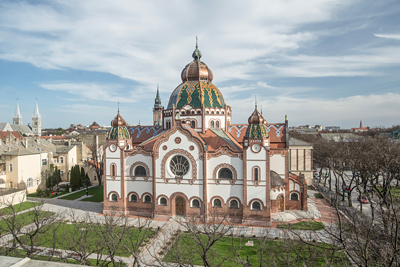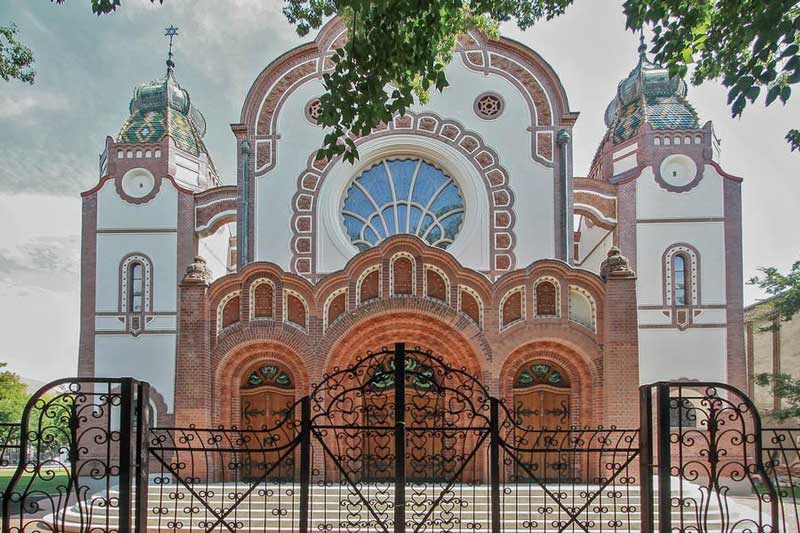
Built in 1901, as a place of worship for the Neologs, one of the two predominant Hungarian Jewish communities, Subotica Synagogue is the second largest synagogue in Europe and is one of the finest surviving religious architecture in the Hungarian Art Nouveau style remaining in the world today.
Constructed during the administration of the Kingdom of Hungary, part of Austria-Hungary, it is also known as the Jakab and Komor Square Synagogue, after the names of its architects Dezső Jakab and Marcell Komor. It also gracefully highlights the Hungarian-Jewish identity of its builders, who lived in a multi-ethnic, but predominantly Catholic city, which was the third largest city of the Hungarian Kingdom and the tenth largest of the vast Habsburg Empire.

The architects of the Subotica Synagogue were ardent followers of Ödön Lechner, the father of Hungarian art nouveau style architecture and later partisans of the movement, which unified Hungarian folklore elements with some Jewish structural principles and sometimes even Jewish motifs.
Apart from giving the synagogue a distinct double identity in architectural terms, they created a new space-conception of synagogue architecture in Hungary by deploying a modern steel structure, along with an advanced technique of vaulting. While the period synagogues in the country featured a predominantly basilica-like arrangement with a nave and two aisles, with or without a dome, the Subotica Synagogue represents a unified, tent-like central space under the sun, painted in gold on the apex of the dome.

While many other synagogues with light structures usually mimicked traditional arches and vaults, the novelty of Subotica Synagogue is its sincere display of modern structures, applying modern techniques, which the Jews in general advocate and generate. The women’s gallery of the synagogue, along with the dome, is supported by four pairs of steel pillars aesthetically covered with gypsum with a palm leaf relief and the self supporting large dome is created in the true spirit of the Hungarian folklore.
The interior of the dome is constructed of light concrete by applying an unusual and technologically sophisticated shell-construction technique, while the roof of the building is covered with elaborate Zsolnay-glazed roof tiles. The interior of the synagogue is decorated with fine art nouveau paintings, carved and moulded finishes and Zsolnay ceramic works.

Unfortunately, the majestic building suffered damage due to negligence and the continued lack of maintenance for many years, mainly as a result of severe economic hardship and political conflict that prevailed in the region. But despite being plagued by conservation issues for a long time, it was saved from becoming ruins due to the active partnership between the government and the World Monuments Fund, which worked together for the conservation of the edifice for more than fifteen years. Primarily, the work focused on repairing the roof of the building, broken windows and the decayed wooden roof support, for the protection of the significant artistic and architectural treasures of the synagogue. After the renovation of four lower cupolas, along with the central dome and the roof gables, the surface of the roof was restored, complete with the water drainage system and finally, rendering the waterproofing of the roof after years of chronic leakage. Restoration of the southwest façade, including restoration of the main tripartite entrance, replacement of some decayed bricks and repairing of a small arched Tiffany window were taken care of during the fall of 2012. However, even after the end of the partnership, the synagogue was again fully renovated in a multi-million renovation project financed mainly by the Hungarian and Serbian governments and reopened in March 2018.


The magnificent Subotica Synagogue signifies a marvellous manifestation of religious perseverance and cultural coexistence, which multiple wars failed to topple. Even it survived World War II, when Nazi Germany was busy with brutally and systematically annihilating the Jewish community. It is the second largest synagogue in Europe after the Dohany Street Synagogue in Budapest and a prominent and dignified reminder of the long and prominent history of Jewish culture in the country. The synagogue, designated a Monument of Culture in 1974, became a Monument of Culture of Exceptional Importance in 1990 and is protected by the Republic of Serbia.